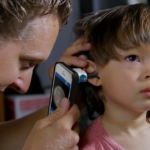Study tackles non-surgical treatment of knee osteoarthritis
This study is a head-to-head comparison of non-surgical treatment of knee osteoarthritis and total knee replacement surgery. Here is what they found.

Florence Dressler illustration in Feminology 1902, page 607. Library of Congress, Archive.org and Wikimedia Commons. Orthopedics This Week.
Elizabeth Hofheinz MPH MEd, Orthopedics This Week September 7, 2018
Søren Thorgaard Skou PT MSc PhD, associate professor in the Research Unit for Musculoskeletal Function and Physiotherapy at the University of Southern Denmark and his colleagues set out to extend their initial work on the non-surgical management of knee osteoarthritis (OA). Their study was published in the September 2018 edition of Osteoarthritis and Cartilage.
Dr. Skou told OTW, “Total knee replacement (TKR) is the second most common orthopedic procedure performed. In 2013, more than 700,000 patients had a TKR in the U.S. This number is projected to increase rapidly in the next years. However, until we published our randomized trial in 2015, no high-quality trials had investigated the effects of the procedure as compared to non-surgical management, such as exercise and weight loss, in patients with knee OA.”
“In this extended follow-up of that 2015 study, we combined the 2-year results from two randomized [studies] to allow for a more in-depth discussion of the roles of advice, non-surgical management and total knee replacement as treatments of knee OA.”
“The two trials were similarly designed, used the same outcomes and were conducted parallel in time with patients recruited from the same surgeons and sites, but differed on whether the patients were eligible for total knee replacement or not. The results will therefore facilitate shared decision making on what treatment best meets the need and expectations of the individual patient, thereby being an important step towards individualized and optimized treatment.”
“We found that TKR followed by non-surgical treatment, was associated with greater pain relief and functional improvement than non-surgical treatment alone which resulted in greater improvements than written advice after two years.”
“While the surgical procedure was associated with a risk of serious adverse events, no one in the group of patients undergoing non-surgical treatment only had a serious adverse event related to their knee.”
“Patients having non-surgical treatment could at any time approach a surgeon to discuss having their joint replaced. However, only one out of three patients eligible for total knee replacement in the group randomized to non-surgical treatment alone did undergo TKR within two years. This finding indicates that two out of three patients with severe enough knee OA to warrant having their knee replaced for a prosthesis actually find their improvement from non-surgical treatment large enough not to have surgery for at least two years.”
“All patients with knee OA should undergo a supervised non-surgical treatment regime before considering surgery. The program should at least include exercise therapy and education and weight loss if the patient is overweight, and it is important that the duration of the exercise therapy program is at least 12 supervised sessions (2 sessions per week for 6 weeks), but 24 or more sessions is likely to result in larger effects.”
“This has the potential to postpone surgery for at least two years for most patients. If the patient and physician decide that TKR is needed, the procedure is effective and recommended in addition to non-surgical treatment.”
“It is important that the patient has undergone a supervised non-surgical treatment program of sufficient dose and length before considering TKR. Question your patient about the exercise therapy program that they have undergone. If it does not match the practical recommendations given above, make sure they try this before considering surgery.”
Source Orthopedics This Week
| References |
Total knee replacement and non-surgical treatment of knee osteoarthritis: 2-year outcome from two parallel randomized controlled trials, Skou ST, Roos EM, Laursen MB, Rathleff MS, Arendt-Nielsen L, Rasmussen S, Simonsen O. Osteoarthritis Cartilage. 2018 Sep;26(9):1170-1180. doi: 10.1016/j.joca.2018.04.014. Epub 2018 May 1.
A Randomized, Controlled Trial of Total Knee Replacement, Skou ST, Roos EM, Laursen MB, Rathleff MS, Arendt-Nielsen L, Simonsen O, Rasmussen S. N Engl J Med. 2015 Oct 22;373(17):1597-606. doi: 10.1056/NEJMoa1505467
| Further reading |
Cost-effectiveness of total knee replacement in addition to non-surgical treatment: a 2-year outcome from a randomised trial in secondary care in Denmark, Skou ST, Roos E, Laursen M, Arendt-Nielsen L, Rasmussen S, Simonsen O, Ibsen R, Larsen AT, Kjellberg J. BMJ Open. 2020 Jan 15;10(1):e033495. doi: 10.1136/bmjopen-2019-033495. Full text
Three groups of dissatisfied patients exist after total knee arthroplasty: early, persistent, and late, Clement ND, Bardgett M, Weir D, Holland J, Gerrand C, Deehan DJ. Bone Joint J. 2018 Feb;100-B(2):161-169. doi: 10.1302/0301-620X.100B2.BJJ-2017-1016.R1.
Revisiting patient satisfaction following total knee arthroplasty: a longitudinal observational study, Bryan S, Goldsmith LJ, Davis JC, Hejazi S, MacDonald V, McAllister P, Randall E, Suryaprakash N, Wu AD, Sawatzky R. BMC Musculoskelet Disord. 2018 Nov 30;19(1):423. doi: 10.1186/s12891-018-2340-z
Also see
Knee osteoarthritis: Overview of current and evolving treatment Orthopedics This Week






